Have you ever wanted to use a particular dataset, but you didn’t know its history, completeness, purpose, or accuracy? If you do not know much about your data, it is difficult to know how reliable and useful your analysis is. Metadata provides a way to document information about your data so that potential users of that data will be able to see if it is suitable for their needs. Metadata allows for the effective sharing of data and knowledge across an organization or a larger community of GIS users. For this reason, metadata is essential to the effective use of a GIS. In this blog you will be introduced to metadata tools available in ArcGIS Pro.
In ArcGIS Pro you can document the content and project items you create and use, these include your maps, projects, geoprocessing models and geodatabase datasets. In ArcGIS, metadata is saved with the item it describes, for example for a geodatabase the geodatabase items, in the project for project items and on the file system for file-based items. Once created, metadata is copied, moved, and deleted with the item when it’s managed by ArcGIS.
Update map metadata
1. Click Explore Metadata in ArcGIS Pro and choose Open in ArcGIS Pro to download the item. Next, click the downloaded item to launch and open it in ArcGIS Pro.
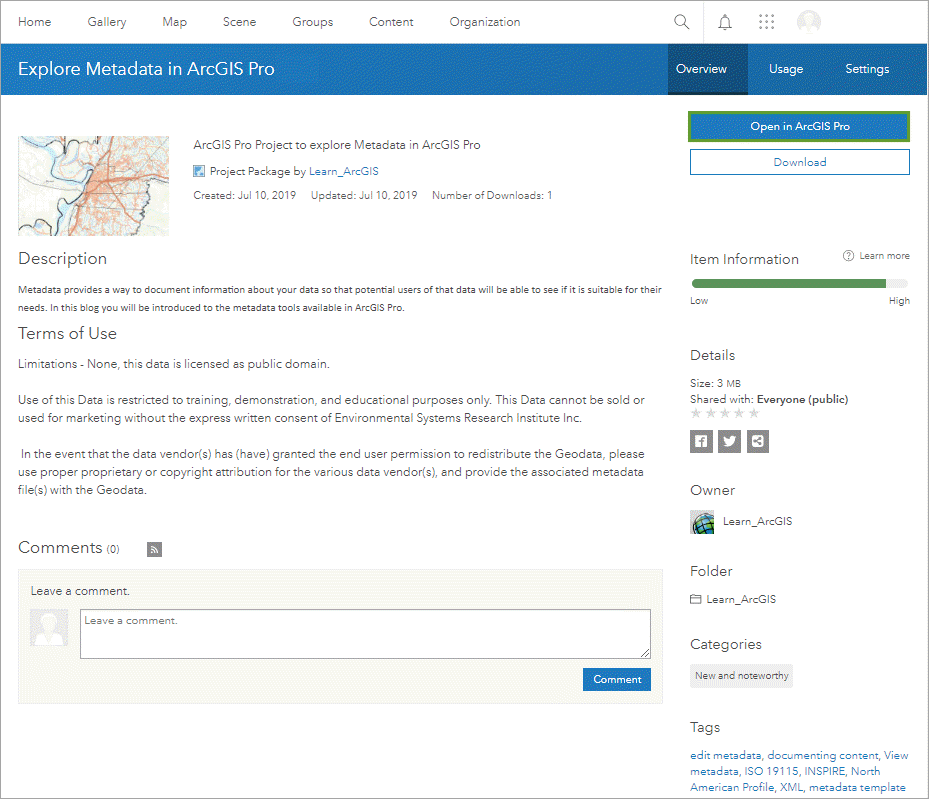
2. In ArcGIS Pro, if prompted, sign in using your licensed ArcGIS account.
Note: If you don’t have ArcGIS Pro or an ArcGIS account, you can sign up for an ArcGIS free trial.
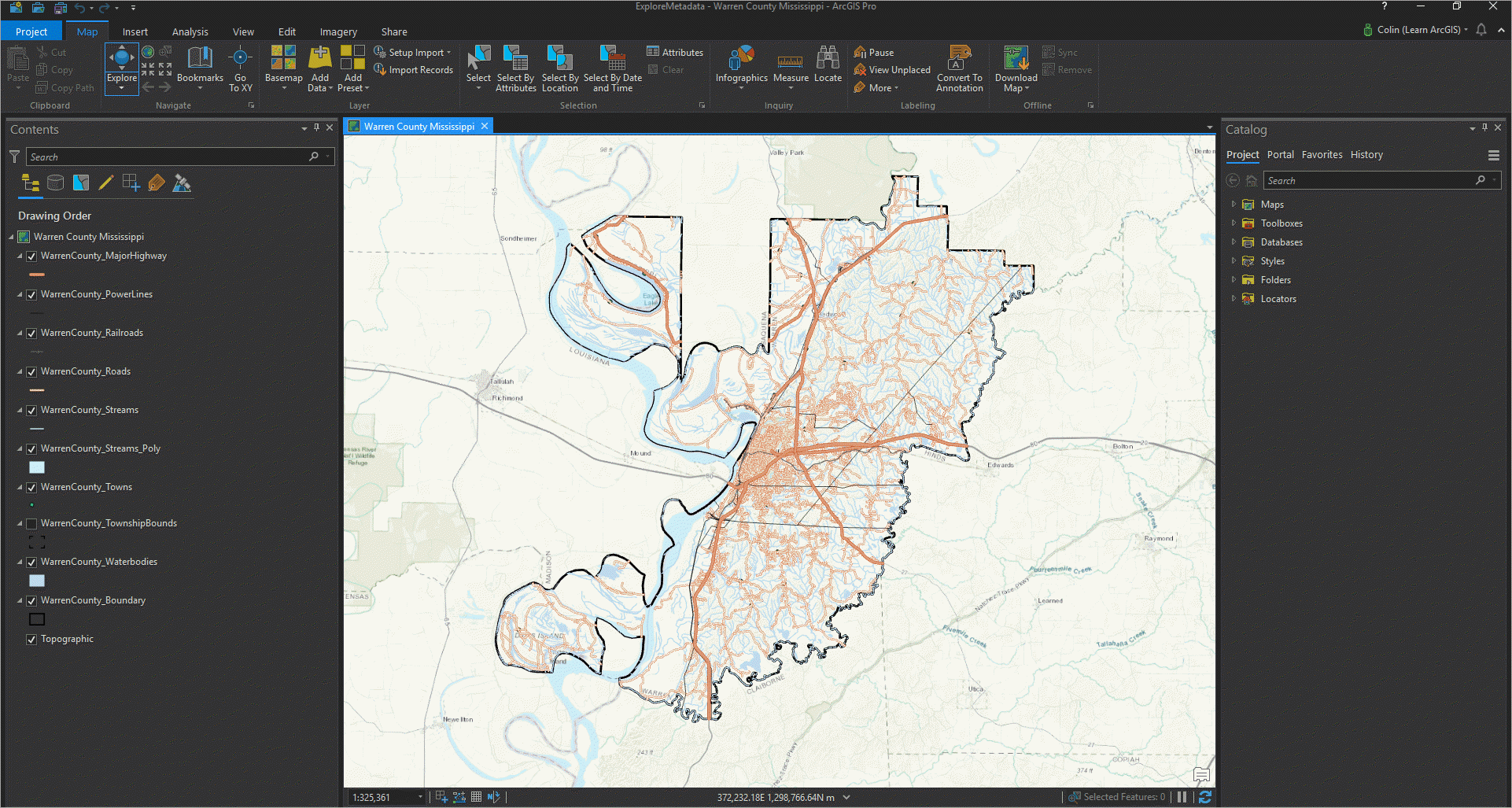
The ExploreMetadata ArcGIS Pro project opens to display a map containing layers of data for Warren County Mississippi. It would be useful to know more about the history, completeness, purpose and accuracy of the data from which the layers in the Warren County Mississippi map were derived.
Before you investigate the data, let’s check if the project contains any information describing the Warren County Mississippi map.
3. On the ribbon, on the Project tab, then click Options.
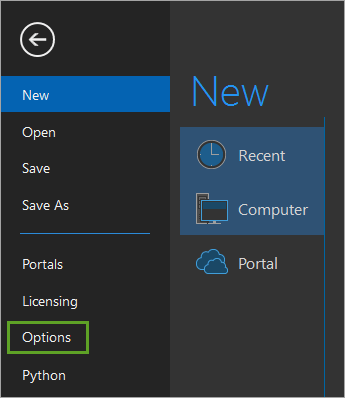
4. In the Options pane for Project options, choose Metadata.
ArcGIS Pro is set to use the Item Description metadata style by default, other metadata styles are available that provide access to more of an item’s metadata content. Next, you will change the metadata style to the Federal Geographic Data Committee‘s (FGDC) Content Standard for Digital Spatial Metadata (CSDGM) which is a well-known metadata content standard that has been used in North America and around the world for many years.
5. From the Metadata style drop-down menu, choose FGDC CSDGM Metadata and click OK.
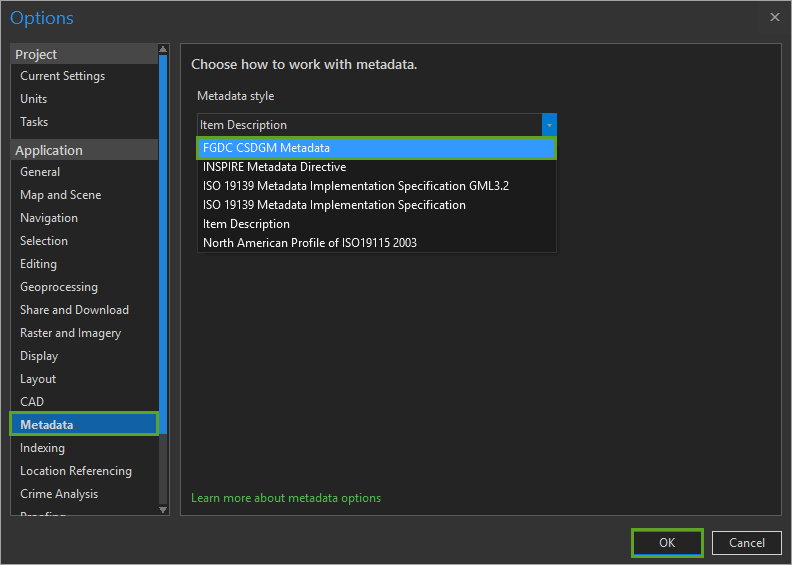
6. Click the Back button to return to the project.
7. In the Catalog pane, expand Maps.
8. In the list of maps, right-click Warren County Mississippi, and choose View Metadata.
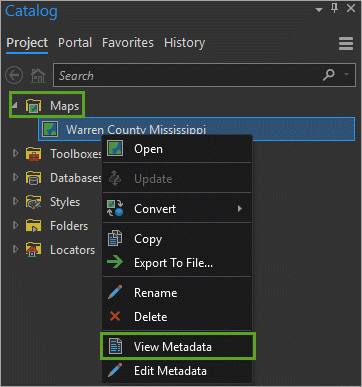
9. Close the Catalog pane.
Note: The Catalog pane and the Catalog view are similar, but designed toward different tasks. Both the Catalog pane and the Catalog view can be open at the same time, but they operate independently. In both the pane and the view, you can manage and browse data. As you generate new items, they are categorized by type and appear on the project tab in the Catalog pane as well as in the project collection in the Catalog view.
You will use the Catalog View while updating metadata. The Catalog View displays a details panel with the current metadata for the map.
Your map has no metadata defined, it would be useful if it had a summary of the data layers and a description of the symbology and coordinate system used for the map.
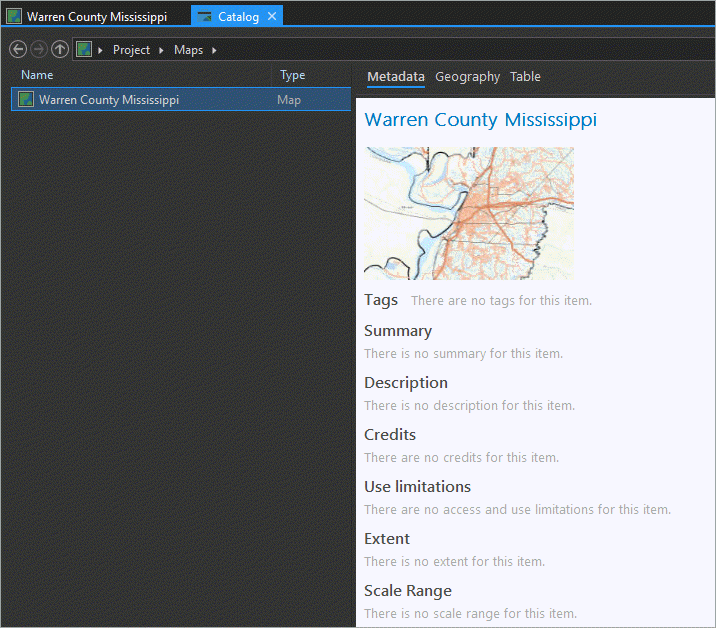
Hint: If you mistakenly close the Catalog view, you can reopen it from the View tab on the ribbon, in the Windows group, by clicking Catalog View.
10. If necessary, click anywhere inside the Catalog view, for the ribbon to update and display the Catalog tab with a Metadata group.

The Metadata group contains functionality to edit, import, export and upgrade metadata.
11. In the Catalog view, click Geography.
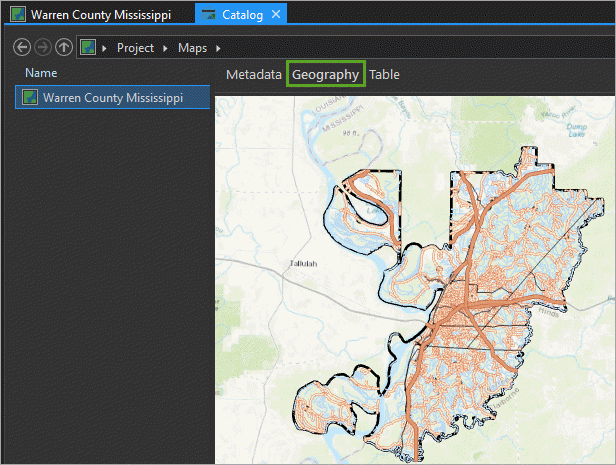
12. On the ribbon click the Preview tab in the Navigate group, use the Pan and Zoom tools to update the display extent to Warren County.
13. In the Preview group, click Create Thumbnail.
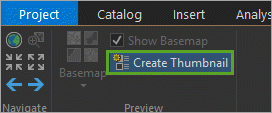
14. In the Catalog view, click Metadata to review the updated thumbnail in the Details pane.
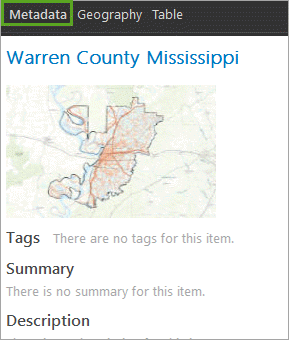
Next you’ll edit the map metadata.
15. On the ribbon on the Catalog tab, in the Metadata group, click Edit.
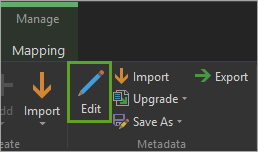
The metadata editor pane displays.
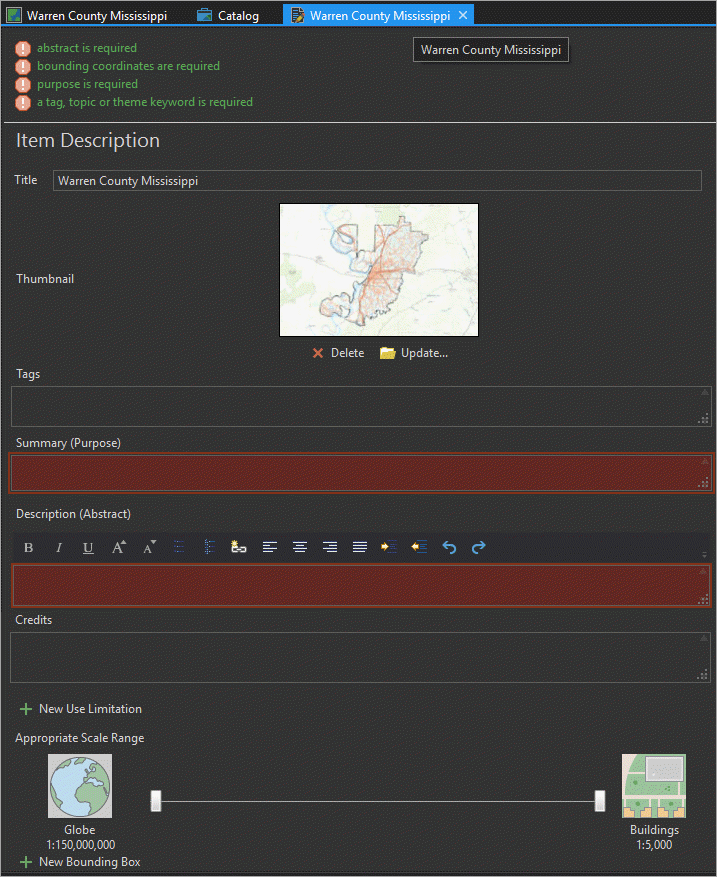
16. Review the Contents pane and note that it displays available metadata categories that may be updated; these include an overview, metadata and resources page.
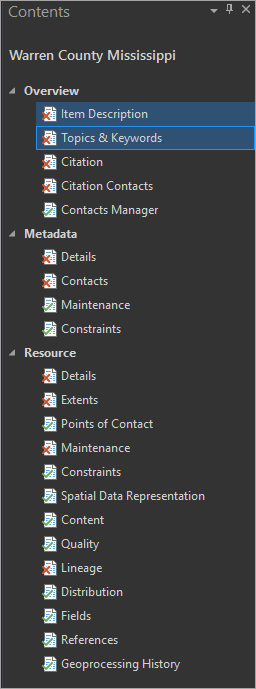
17. In the Metadata editor pane, add the following information:
- For Title, type – Warren County Mississippi Map
- For Tags, type – Warren County Mississippi, County Boundary, Major Highways, Powerlines, Railroads, Roads, Streams, Towns, Township boundaries, Waterbodies
- For Summary (Purpose), type – Warren County Mississippi map of base data compiled as part of a statewide GIS repository effort.
- For Description (Abstract), type – A map containing vector data set layers of base data for Warren County Mississippi. Created using 1990 US Census Bureau TIGER files and periodically updated. The data for county-wide files have been clipped using 1:100,000 county borders from USGS Census TIGER files. In 2012, MARIS staff updated linework using 2006 MDEM 2 foot imagery, 2010 1 meter USDA NAIP Imagery, MS DOT’s 2009 Official road Map of Mississippi, and 1 foot BING Pictometry imagery.
- For Credits, type – Mississippi Automated Resource Information System (MARIS) Technical Center
- Set the minimum Appropriate Scale Range to 1:500,000 and the maximum to 1:5,000
- For Bounding Box, click New Bounding Box and type the following coordinates.
West -91.175758 East -90.550942 South 32.079123 North 32.619685
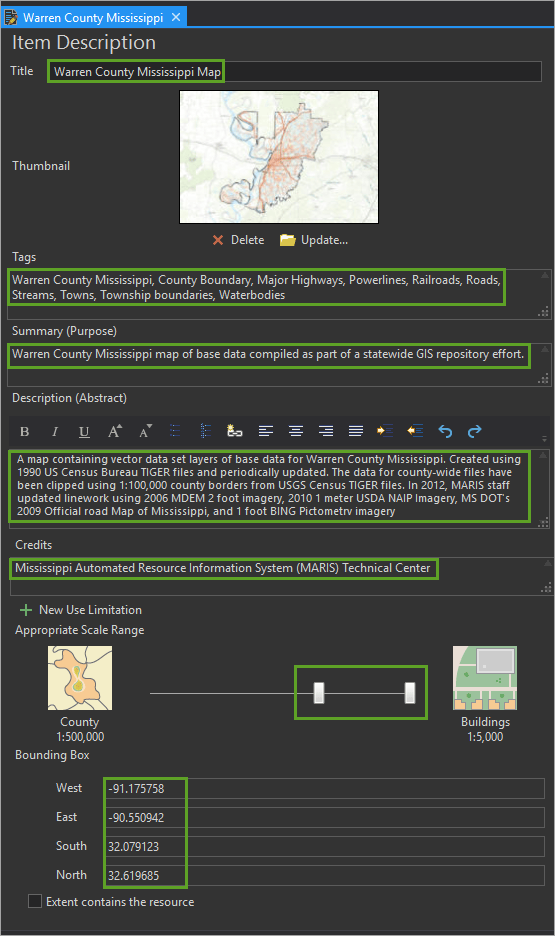
Note: When you author or update metadata content for an ArcGIS item, record the information that is important for your organization to know about that item. This might include how accurate and recent the item is, restrictions on using and sharing the item, important processes in its life cycle such as generalizing features, and so on
18. On the ribbon, on the Metadata tab, in the Manage Metadata group, click Apply and click Save.
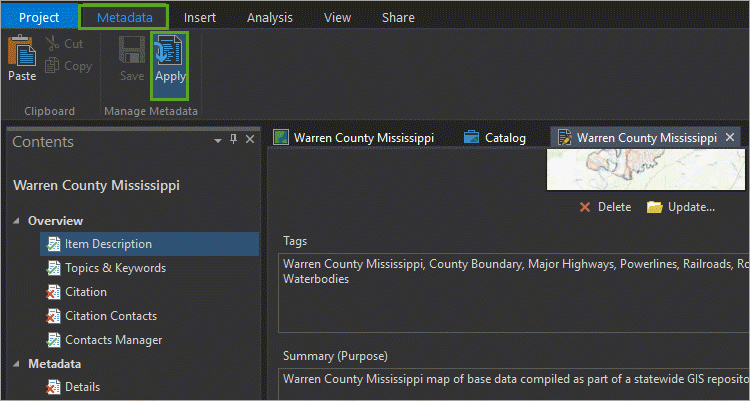
19. On the ribbon, click in the Project tab, click Save.
By saving the project, all changes made to the project since the last save are persisted, including the edits you made to the Warren County map metadata.
20. Return to the Catalog view to preview your changes.
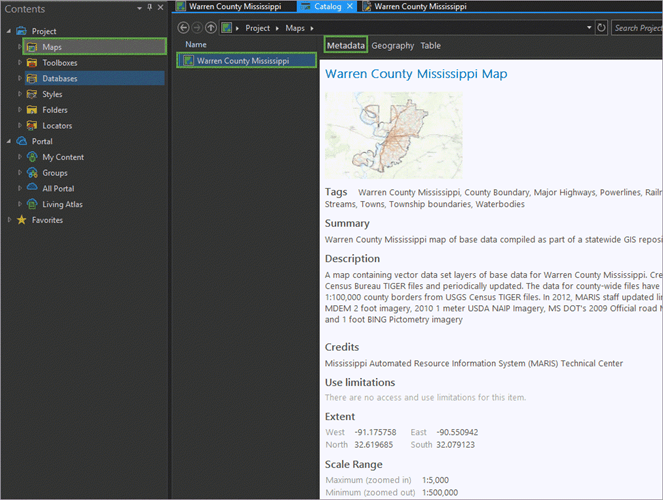
21. Close the Warren County Mississippi metadata editor pane.
When care is taken to provide good descriptive information, you can find items with a search, and evaluate which item in your search results is the correct one to use. You can improve communication and have confidence in decisions based on an item’s geospatial information. You can archive projects knowing they can be recovered, used, and evaluated in the future
You can also explore more information about viewing and editing metadata
Now that you have updated the metadata for your project map, you’ll review the metadata for the data sources referenced by the map.
Explore geodatabase metadata
1. If necessary, click the Catalog view pane.
The Contents pane updates to display the ExploreMetadata project items.
2. In the Catalog pane, expand Databases, and expand exploremetadata.gdb
3. Right-click the WarrenCounty_Boundary feature class and select View Metadata.
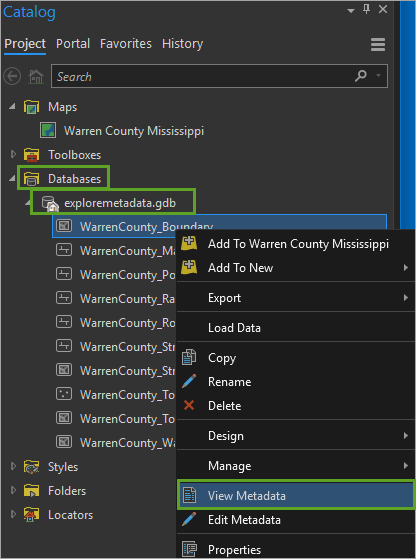
The Catalog view updates to display the current metadata for the feature class.
4. In the Catalog view, in the Details pane, review the available metadata for the WarrenCounty_Boundary feature class.
Remember you changed metadata style and are currently applying the FGDC CSDGM metadata style.
5. Review the Details pane, note the Tags and Description, that includes the data origin, lineage and update history.
The MARIS Technical Center is the source of this feature class. The center staff appear to have spent considerable time and effort to document this data, thereby making it both useful and searchable.
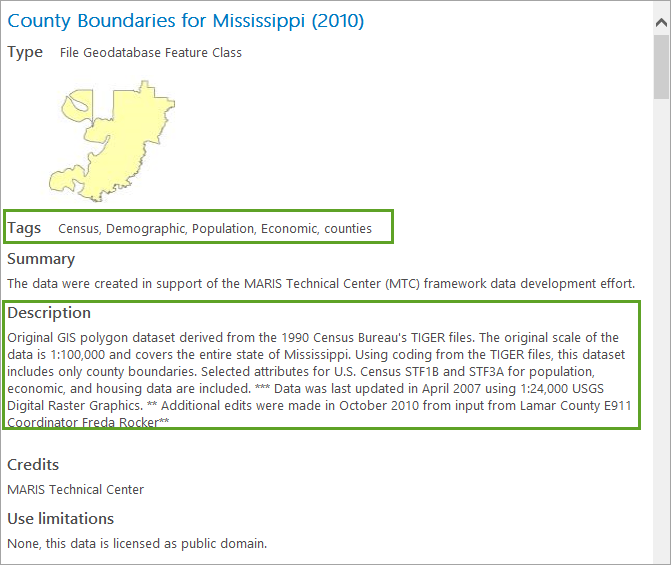
6. Scroll down the Details pane until you reach the Extent and Scale Range values.
These values have also been set correctly.
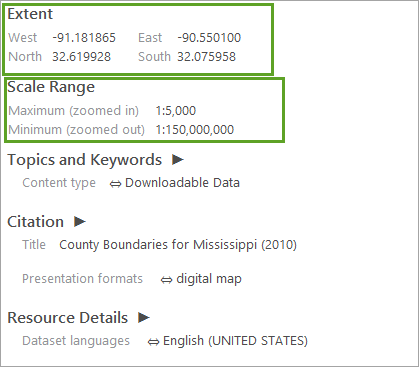
7. Scroll down the Details pane until you reach the Spatial Reference section.
The projection is defined as mstm. This is state of Mississippi specific spatial reference system developed to store geographic data for entire state in a single projected system.
It has the following properties:
- Unit: meter
- Geodetic CRS: NAD83(2011)
- Datum: NAD83 (National Spatial Reference System 2011)
- Ellipsoid: GRS 1980
- Prime meridian: Greenwich
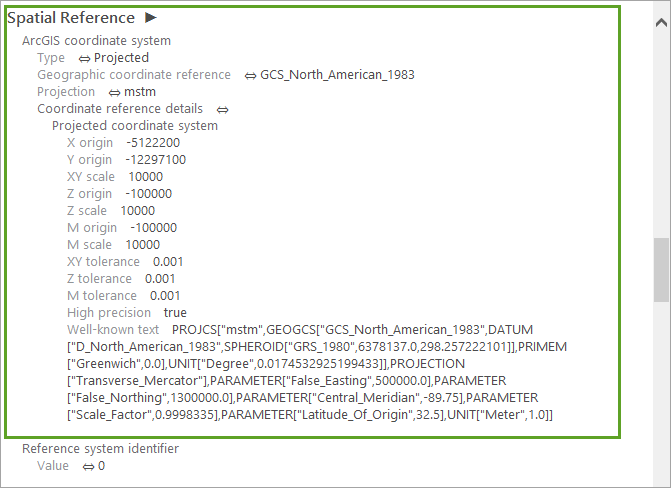
8. Scroll down until you reach the Geoprocessing history section.
This data source represents a selection made from an original shapefile containing all counties in the state of Mississippi.
The fact that the data was originally sourced from a shapefile is a good indicator of possible limitations. Shapefiles do not contain an x,y tolerance like geodatabase feature classes and dont support circular arc curves that use a mathematical formula to draw the curve.
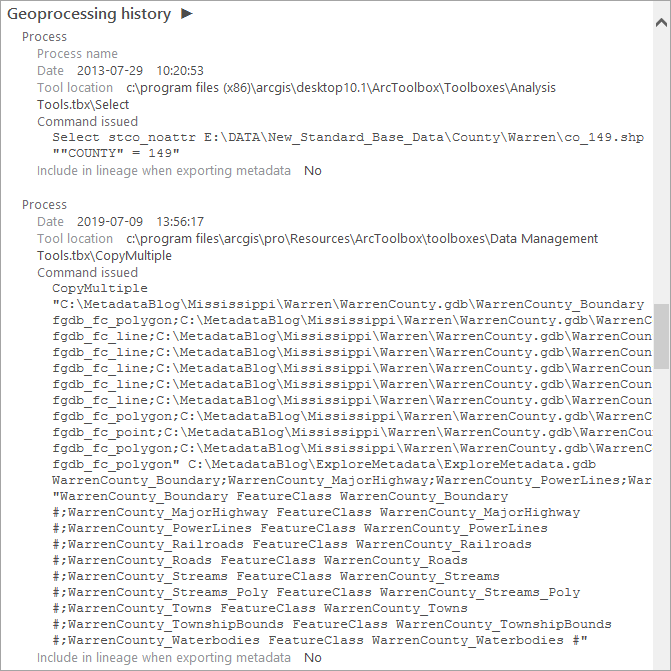
9. Scroll down until you reach the Field section.
Again the fact that the source for this data was a shapefile is a good indicator of potential attribute limitations.
For shapefiles the following limitations apply:
- Field names cannot be longer than 10 characters.
- The maximum record length for an attribute is 4,000 bytes
- They do not support type BLOB, GUID, global ID, coordinate ID, or raster field types.
- Null values are not supported.
- Date fields only support date an do not support time.
Thus by reviewing the field descriptions and field types you can determine if this data source is constrained by the original shapefile properties.
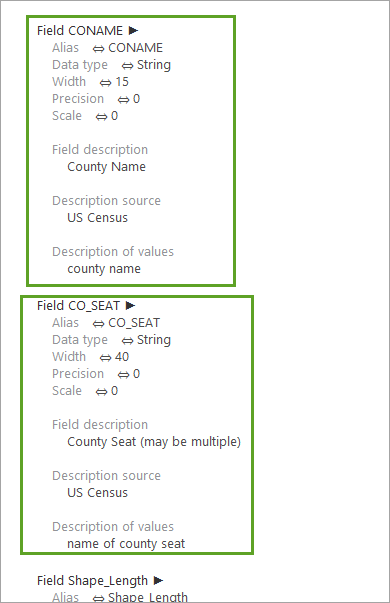
10. On your own, investigate the metadata for the additional feature classes in exploremetadata.gdb .
11. Change the metadata style and review the differences between both the formatting and the level of detail displayed by each style.
What’s next?
When you are ready to update and create metadata for your own projects and data, you can streamline the task by creating a metadata template. An organization-wide metadata template can include basic contact and distribution information and legal restrictions that apply to all items. An organizational template can be the basis for project-specific templates that include the purpose for which the project and its items were created, standard place names describing the geographic region in which the work takes place, and how the project’s deliverables will be distributed and maintained.
The best way to create a metadata template is to fully document an item, and save a copy of its metadata as a template. This process creates a stand-alone metadata XML file that doesn’t include unique identifiers or any content that was added automatically to the item’s metadata. Edit the content of the stand-alone metadata XML file to generalize or remove any remaining content that is specific to the original item. The result should be appropriate to use with many items.
To learn more, review Best practices for editing metadata.



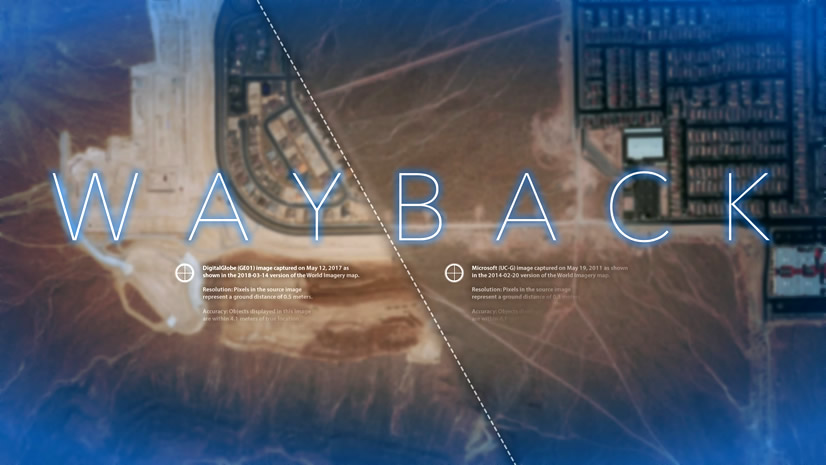
Commenting is not enabled for this article.